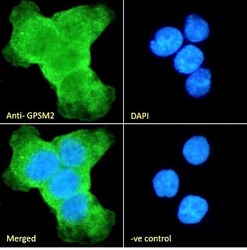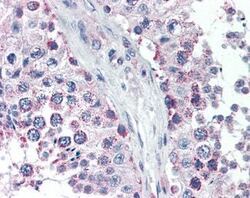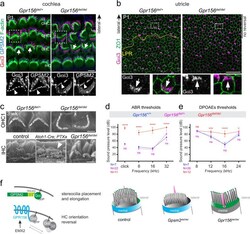Antibody data
- Antibody Data
- Antigen structure
- References [1]
- Comments [0]
- Validations
- Immunocytochemistry [1]
- Immunohistochemistry [1]
- Other assay [1]
Submit
Validation data
Reference
Comment
Report error
- Product number
- PA5-18646 - Provider product page

- Provider
- Invitrogen Antibodies
- Product name
- GPSM2 Polyclonal Antibody
- Antibody type
- Polyclonal
- Antigen
- Synthetic peptide
- Description
- This antibody is predicted to react with canine based on sequence homology. This antibody is tested in Peptide ELISA: antibody detection limit dilution 64,000.
- Reactivity
- Human
- Host
- Goat
- Isotype
- IgG
- Vial size
- 100 μg
- Concentration
- 0.5 mg/mL
- Storage
- -20°C, Avoid Freeze/Thaw Cycles
Submitted references EMX2-GPR156-Gαi reverses hair cell orientation in mechanosensory epithelia.
Kindt KS, Akturk A, Jarysta A, Day M, Beirl A, Flonard M, Tarchini B
Nature communications 2021 May 17;12(1):2861
Nature communications 2021 May 17;12(1):2861
No comments: Submit comment
Supportive validation
- Submitted by
- Invitrogen Antibodies (provider)
- Main image

- Experimental details
- Immunocytochemistry analysis of GPSM2 using GPSM2 Polyclonal Antibody (Product # PA5-18646) in paraformaldehyde fixed A431 cells, permeabilized with 0.15% Triton. Primary incubation 1hr (10 µg/mL) followed by Alexa Fluor 488 secondary antibody (2 µg/mL), showing cytoplasmic staining. The nuclear stain is DAPI (blue). Negative control: Unimmunized goat IgG (10 µg/mL) followed by Alexa Fluor 488 secondary antibody (2 µg/mL).
Supportive validation
- Submitted by
- Invitrogen Antibodies (provider)
- Main image

- Experimental details
- Immunohistochemistry analysis of GPSM2 in human testis. Samples were incubated with GPSM2 polyclonal antibody (Product # PA5-18646) using a dilution of 5 µg/mL. Formalin-fixed, paraffin-embedded tissue after heat-induced antigen retrieval.
Supportive validation
- Submitted by
- Invitrogen Antibodies (provider)
- Main image

- Experimental details
- Fig. 7 GPR156-Galphai and GPSM2-Galphai are distinct functional modules in developing hair cells. a , b Normal apical enrichment of GPSM2-Galphai3 ( a ) or Galphai3 ( b ) in P1 Gpr156 mutant HCs in the cochlea ( a ) and utricle ( b ). Arrows indicate HC orientation. Note how GPSM2-Galphai3 enrichment follows HC orientation when HCs are inverted (OHC1-2s in a ) or fail to reverse orientation (lateral HCs in b ). Bottom panels show a magnified view of the HC boxed in the upper panels, and arrowheads point to GPSM2-Galphai3 at stereocilia tips ( a ). See Supplementary Fig. 7a for saccule results. c Scanning electron microscopy views of OHC1s (top) and IHCs (bottom) at 3 week (wk). IHC stereocilia stunting is obvious in PTXa (arrowhead) but not Gpr156 mutants. See Supplementary Fig. 7b for larger field views. d , e Auditory brainstem response (ABR, d ) and distortion product otoacoustic emissions (DPOAEs, e ) thresholds at ~4 week of age. X axis indicates broadband (click) and pure tone stimuli for ABR ( d ), or f2 for 2f1-f2 emission for DPOAEs ( e ). Y axis indicates the threshold of sound pressure level eliciting a response ( d ) or generating DPOAEs above noise floor ( e ) (mean +- SD; N indicates the number of animals tested per genotype; ABR click: Mann-Whitney test (two-tailed), **** p < 0.0001, ns p = 0.4943; ABR pure tones: two-way ANOVA with Sidak's multiple comparisons, **** p < 0.0001, ns is p = 0.6928 (8 kHz), p = 0.9167 (16 kHz), p = 0.1061 (32 kHz); DPOAE: two-way
 Explore
Explore Validate
Validate Learn
Learn Immunocytochemistry
Immunocytochemistry